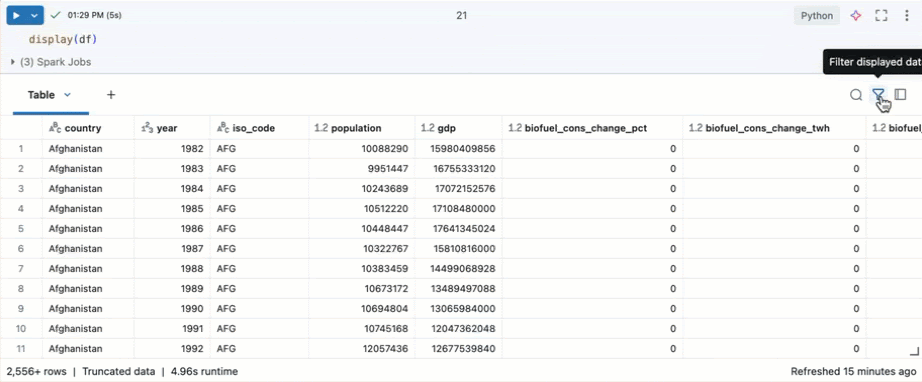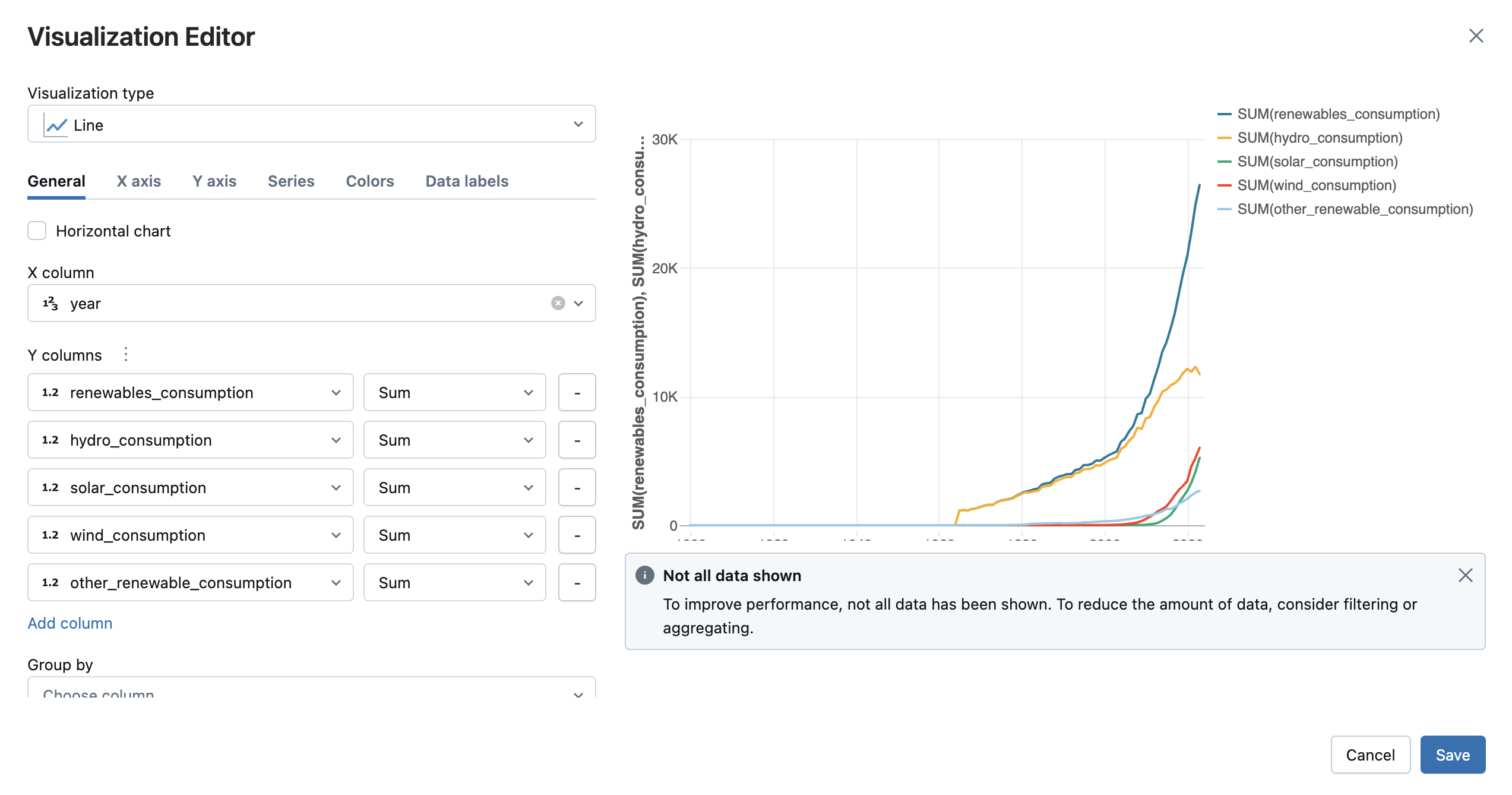
6
8
(21812, 130)
9
country object
year int64
iso_code object
population float64
gdp float64
...
wind_elec_per_capita float64
wind_electricity float64
wind_energy_per_capita float64
wind_share_elec float64
wind_share_energy float64
Length: 130, dtype: object
10
12
16
18
Duplicate rows count: 0
Duplicate columns: []
22
dtype('int64')
24
27
array(['ASEAN (Ember)', 'Afghanistan', 'Africa', 'Africa (EI)',
'Africa (EIA)', 'Africa (Ember)', 'Africa (Shift)', 'Albania',
'Algeria', 'American Samoa', 'Angola', 'Antarctica',
'Antigua and Barbuda', 'Argentina', 'Armenia', 'Aruba', 'Asia',
'Asia & Oceania (EIA)', 'Asia (Ember)', 'Asia Pacific (EI)',
'Asia and Oceania (Shift)', 'Australia',
'Australia and New Zealand (EIA)', 'Austria', 'Azerbaijan',
'Bahamas', 'Bahrain', 'Bangladesh', 'Barbados', 'Belarus',
'Belgium', 'Belize', 'Benin', 'Bermuda', 'Bhutan', 'Bolivia',
'Bosnia and Herzegovina', 'Botswana', 'Brazil',
'British Virgin Islands', 'Brunei', 'Bulgaria', 'Burkina Faso',
'Burundi', 'CIS (EI)', 'Cambodia', 'Cameroon', 'Canada',
'Cape Verde', 'Cayman Islands', 'Central & South America (EIA)',
'Central African Republic', 'Central America (EI)',
'Central and South America (Shift)', 'Chad', 'Chile', 'China',
'Colombia', 'Comoros', 'Congo', 'Cook Islands', 'Costa Rica',
"Cote d'Ivoire", 'Croatia', 'Cuba', 'Curacao', 'Cyprus', 'Czechia',
'Czechoslovakia', 'Democratic Republic of Congo', 'Denmark',
'Djibouti', 'Dominica', 'Dominican Republic', 'EU28 (Shift)',
'East Germany', 'East Timor', 'Eastern Africa (EI)', 'Ecuador',
'Egypt', 'El Salvador', 'Equatorial Guinea', 'Eritrea', 'Estonia',
'Eswatini', 'Ethiopia', 'Eurasia (EIA)', 'Eurasia (Shift)',
'Europe', 'Europe (EI)', 'Europe (EIA)', 'Europe (Ember)',
'Europe (Shift)', 'European Union (27)', 'Falkland Islands',
'Faroe Islands', 'Fiji', 'Finland', 'France', 'French Guiana',
'French Polynesia', 'G20 (Ember)', 'G7 (Ember)', 'Gabon', 'Gambia',
'Georgia', 'Germany', 'Ghana', 'Gibraltar', 'Greece', 'Greenland',
'Grenada', 'Guadeloupe', 'Guam', 'Guatemala', 'Guinea',
'Guinea-Bissau', 'Guyana', 'Haiti', 'High-income countries',
'Honduras', 'Hong Kong', 'Hungary', 'Iceland', 'India',
'Indonesia', 'Iran', 'Iraq', 'Ireland', 'Israel', 'Italy',
'Jamaica', 'Japan', 'Jordan', 'Kazakhstan', 'Kenya', 'Kiribati',
'Kosovo', 'Kuwait', 'Kyrgyzstan', 'Laos',
'Latin America and Caribbean (Ember)', 'Latvia', 'Lebanon',
'Lesotho', 'Liberia', 'Libya', 'Lithuania', 'Low-income countries',
'Lower-middle-income countries', 'Luxembourg', 'Macao',
'Madagascar', 'Malawi', 'Malaysia', 'Maldives', 'Mali', 'Malta',
'Martinique', 'Mauritania', 'Mauritius', 'Mexico',
'Micronesia (country)', 'Middle Africa (EI)', 'Middle East (EI)',
'Middle East (EIA)', 'Middle East (Ember)', 'Middle East (Shift)',
'Moldova', 'Mongolia', 'Montenegro', 'Montserrat', 'Morocco',
'Mozambique', 'Myanmar', 'Namibia', 'Nauru', 'Nepal',
'Netherlands', 'Netherlands Antilles', 'New Caledonia',
'New Zealand', 'Nicaragua', 'Niger', 'Nigeria', 'Niue',
'Non-OECD (EI)', 'Non-OECD (EIA)', 'Non-OPEC (EI)',
'Non-OPEC (EIA)', 'North America', 'North America (EI)',
'North America (Ember)', 'North America (Shift)', 'North Korea',
'North Macedonia', 'Northern Mariana Islands', 'Norway',
'OECD (EI)', 'OECD (EIA)', 'OECD (Ember)', 'OECD (Shift)',
'OPEC (EI)', 'OPEC (EIA)', 'OPEC (Shift)', 'Oceania',
'Oceania (Ember)', 'Oman', 'Pakistan', 'Palestine', 'Panama',
'Papua New Guinea', 'Paraguay', 'Persian Gulf (EIA)',
'Persian Gulf (Shift)', 'Peru', 'Philippines', 'Poland',
'Portugal', 'Puerto Rico', 'Qatar', 'Reunion', 'Romania', 'Russia',
'Rwanda', 'Saint Helena', 'Saint Kitts and Nevis', 'Saint Lucia',
'Saint Pierre and Miquelon', 'Saint Vincent and the Grenadines',
'Samoa', 'Sao Tome and Principe', 'Saudi Arabia', 'Senegal',
'Serbia', 'Serbia and Montenegro', 'Seychelles', 'Sierra Leone',
'Singapore', 'Slovakia', 'Slovenia', 'Solomon Islands', 'Somalia',
'South Africa', 'South America', 'South Korea', 'South Sudan',
'South and Central America (EI)', 'Spain', 'Sri Lanka', 'Sudan',
'Suriname', 'Sweden', 'Switzerland', 'Syria', 'Taiwan',
'Tajikistan', 'Tanzania', 'Thailand', 'Togo', 'Tonga',
'Trinidad and Tobago', 'Tunisia', 'Turkey', 'Turkmenistan',
'Turks and Caicos Islands', 'Tuvalu', 'U.S. Pacific Islands (EIA)',
'U.S. Territories (EIA)', 'USSR', 'Uganda', 'Ukraine',
'United Arab Emirates', 'United Kingdom', 'United States',
'United States Pacific Islands (Shift)',
'United States Territories (Shift)',
'United States Virgin Islands', 'Upper-middle-income countries',
'Uruguay', 'Uzbekistan', 'Vanuatu', 'Venezuela', 'Vietnam',
'Wake Island (EIA)', 'Wake Island (Shift)', 'West Germany',
'Western Africa (EI)', 'Western Sahara', 'World', 'Yemen',
'Yugoslavia', 'Zambia', 'Zimbabwe'], dtype=object)
33
42
/databricks/python/lib/python3.10/site-packages/statsmodels/tsa/base/tsa_model.py:471: ValueWarning:
An unsupported index was provided and will be ignored when e.g. forecasting.
/databricks/python/lib/python3.10/site-packages/statsmodels/tsa/base/tsa_model.py:471: ValueWarning:
An unsupported index was provided and will be ignored when e.g. forecasting.
/databricks/python/lib/python3.10/site-packages/statsmodels/tsa/base/tsa_model.py:471: ValueWarning:
An unsupported index was provided and will be ignored when e.g. forecasting.
/databricks/python/lib/python3.10/site-packages/statsmodels/tsa/base/tsa_model.py:834: ValueWarning:
No supported index is available. Prediction results will be given with an integer index beginning at `start`.
47
50
53
56
59
62
65
68


